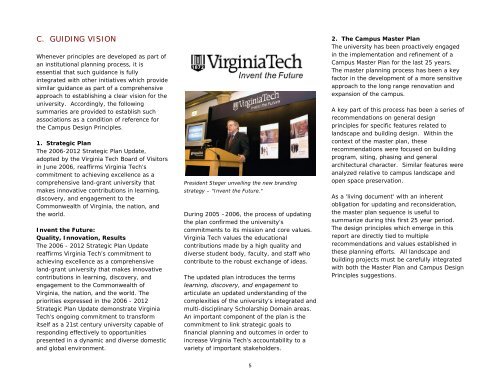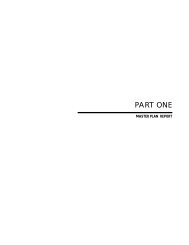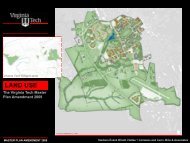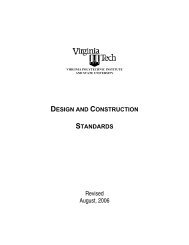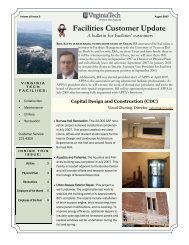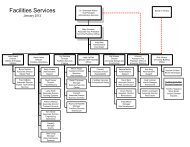Campus Design Principles - Facilities Services - Virginia Tech
Campus Design Principles - Facilities Services - Virginia Tech
Campus Design Principles - Facilities Services - Virginia Tech
You also want an ePaper? Increase the reach of your titles
YUMPU automatically turns print PDFs into web optimized ePapers that Google loves.
C. GUIDING VISION 2. The <strong>Campus</strong> Master Plan<br />
The university has been proactively engaged<br />
Whenever principles are developed as part of<br />
an institutional planning process, it is<br />
essential that such guidance is fully<br />
integrated with other initiatives which provide<br />
similar guidance as part of a comprehensive<br />
approach to establishing a clear vision for the<br />
university. Accordingly, the following<br />
summaries are provided to establish such<br />
associations as a condition of reference for<br />
the <strong>Campus</strong> <strong>Design</strong> <strong>Principles</strong>.<br />
1. Strategic Plan<br />
The 2006-2012 Strategic Plan Update,<br />
adopted by the <strong>Virginia</strong> <strong>Tech</strong> Board of Visitors<br />
in June 2006, reaffirms <strong>Virginia</strong> <strong>Tech</strong>’s<br />
commitment to achieving excellence as a<br />
comprehensive land-grant university that<br />
makes innovative contributions in learning,<br />
discovery, and engagement to the<br />
Commonwealth of <strong>Virginia</strong>, the nation, and<br />
the world.<br />
Invent the Future:<br />
Quality, Innovation, Results<br />
The 2006 - 2012 Strategic Plan Update<br />
reaffirms <strong>Virginia</strong> <strong>Tech</strong>’s commitment to<br />
achieving excellence as a comprehensive<br />
land-grant university that makes innovative<br />
contributions in learning, discovery, and<br />
engagement to the Commonwealth of<br />
<strong>Virginia</strong>, the nation, and the world. The<br />
priorities expressed in the 2006 - 2012<br />
Strategic Plan Update demonstrate <strong>Virginia</strong><br />
<strong>Tech</strong>’s ongoing commitment to transform<br />
itself as a 21st century university capable of<br />
responding effectively to opportunities<br />
presented in a dynamic and diverse domestic<br />
and global environment.<br />
President Steger unveiling the new branding<br />
strategy – "Invent the Future."<br />
During 2005 –2006, the process of updating<br />
the plan confirmed the university’s<br />
commitments to its mission and core values.<br />
<strong>Virginia</strong> <strong>Tech</strong> values the educational<br />
contributions made by a high quality and<br />
diverse student body, faculty, and staff who<br />
contribute to the robust exchange of ideas.<br />
The updated plan introduces the terms<br />
learning, discovery, and engagement to<br />
articulate an updated understanding of the<br />
complexities of the university’s integrated and<br />
multi-disciplinary Scholarship Domain areas.<br />
An important component of the plan is the<br />
commitment to link strategic goals to<br />
financial planning and outcomes in order to<br />
increase <strong>Virginia</strong> <strong>Tech</strong>’s accountability to a<br />
variety of important stakeholders.<br />
in the implementation and refinement of a<br />
<strong>Campus</strong> Master Plan for the last 25 years.<br />
The master planning process has been a key<br />
factor in the development of a more sensitive<br />
approach to the long range renovation and<br />
expansion of the campus.<br />
A key part of this process has been a series of<br />
recommendations on general design<br />
principles for specific features related to<br />
landscape and building design. Within the<br />
context of the master plan, these<br />
recommendations were focused on building<br />
program, siting, phasing and general<br />
architectural character. Similar features were<br />
analyzed relative to campus landscape and<br />
open space preservation.<br />
As a 'living document' with an inherent<br />
obligation for updating and reconsideration,<br />
the master plan sequence is useful to<br />
summarize during this first 25 year period.<br />
The design principles which emerge in this<br />
report are directly tied to multiple<br />
recommendations and values established in<br />
these planning efforts. All landscape and<br />
building projects must be carefully integrated<br />
with both the Master Plan and <strong>Campus</strong> <strong>Design</strong><br />
<strong>Principles</strong> suggestions.<br />
5


